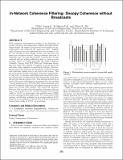In-network coherence filtering: Snoopy coherence without broadcasts
Author(s)
Agarwal, Niket; Peh, Li-Shiuan; Jha, Niraj K.
DownloadAgarwal-2009-In-network coherence filtering Snoopy coherence without broadcasts.pdf (616.5Kb)
PUBLISHER_POLICY
Publisher Policy
Article is made available in accordance with the publisher's policy and may be subject to US copyright law. Please refer to the publisher's site for terms of use.
Terms of use
Metadata
Show full item recordAbstract
With transistor miniaturization leading to an abundance of on-chip resources and uniprocessor designs providing diminishing returns, the industry has moved beyond single-core microprocessors and embraced the many-core wave. Scalable cache coherence protocol implementations are necessary to allow fast sharing of data among various cores and drive the many-core revolution forward. Snoopy coherence protocols, if realizable, have the desirable property of having low storage overhead and not adding indirection delay to cache-to-cache accesses. There are various proposals, like Token Coherence (TokenB), Uncorq, Intel QPI, INSO and Timestamp Snooping, that tackle the ordering of requests in snoopy protocols and make them realizable on unordered networks. However, snoopy protocols still have the broadcast overhead because each coherence request goes to all cores in the system. This has substantial network bandwidth and power implications. In this work, we propose embedding small in-network coherence filters inside on-chip routers that dynamically track sharing patterns among various cores. This sharing information is used to filter away redundant snoop requests that are traveling towards unshared cores. Filtering these useless messages saves network bandwidth and power and makes snoopy protocols on many-core systems truly scalable. Our in-network coherence filters are able to reduce the total number of snoops in the system on an average by 41.9%, thereby reducing total network traffic by 25.4% on 16-processor chip multiprocessor (CMP) systems running parallel applications. For 64-processor CMP systems, our filtering technique on an average achieves 46.5% reduction in total number of snoops that ends up reducing the total network traffic by 27.3%, on an average.
Date issued
2009-12Department
Massachusetts Institute of Technology. Computer Science and Artificial Intelligence Laboratory; Massachusetts Institute of Technology. Department of Electrical Engineering and Computer ScienceJournal
Proceedings of the 42nd Annual IEEE/ACM International Symposium on Microarchitecture
Publisher
Association for Computing Machinery
Citation
Agarwal, Niket, Li-Shiuan Peh, and Niraj K. Jha. “In-network coherence filtering: snoopy coherence without broadcasts.” Proceedings of the 42nd Annual IEEE/ACM International Symposium on Microarchitecture. New York, New York: ACM, 2009. 232-243. Copyright 2009 ACM
Version: Final published version
ISBN
978-1-60558-798-1
Keywords
Performance, Measurement, Design